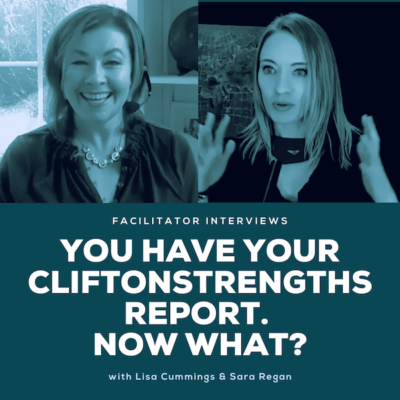The CliftonStrengths Report Says You’re Awesome! Now What?
Podcast: Play in new window
Subscribe: Spotify | iHeartRadio | Email | TuneIn | More

Once You Get Your CliftonStrengths Report, How Should You Take Action?
Your CliftonStrengths report reflects your greatest strengths. As you focus on applying them to work, you might also wonder how to handle situations that call for talent themes way below your top 5 or top 10.
If you're like most people, you'll want to dial up your bottom talents. Unfortunately, this can be a very draining process with a low return on your effort. Instead, your high-leverage will come from studying the top talents in your CliftonStrengths report — then double down on your superpowers.
If you need to take action on your lesser talents at the bottom of the CliftonStrengths report, there are strategies for mitigating these potential weaknesses:
1. You can partner with others who have that as a top talent.
2. You can stop doing some of the activities that call on the low talent area.
3. You can even do a task-switcheroo with a peer so that you're both in your respective strengths zones.
In this interview, Lisa Cummings and StrengthsFinder facilitator Sara Regan reflect on the value of looking at the full CliftonStrengths report as you navigate through work using your strengths.
Here’s the transcript of the insightful conversation between Lisa and Sara:
Lisa: Hello everyone, I'm Lisa Cummings from Lead Through Strengths. So excited today to be joined by Sara Regan, one of our facilitators from Lead Through Strengths, and I'm psyched to bring you some new fresh thinking and tips on applying your CliftonStrengths report (results) at work.
Intentionally Applying Top Talents From Your CliftonStrengths Report
Lisa: A lot of people in the workplace, are thinking about —
“How do I read a room?”
“How do I get comfortable?”
“How do I hone my chops in a skill?”
And usually, people think about putting in the hours,
putting in the work — doing the hustle behind the thing they want to get good at.
What else could you layer on for them, related to using their results from the CliftonStrengths report?
Sara: Right, I guess a few things. 1) I wouldn't discount just putting the time in but putting the time in a very conscious way. To be reflective about what they're learning along the way, can really help people to build that ability to shift and pivot in a little bit more fluency so that level of consciousness strengths come into play.
There will be people who have certain themes and profiles and talents that allow that to happen more naturally. One of the things I like about strengths is it can certainly help us zero in on what we're really gifted at and where our talent lies.
2) When I'm doing coaching with people, or sometimes working with teams and we're looking at the whole 34, there are some lesser themes and it's sometimes they simply need the awareness. Let's take Adaptability, it is a strength that usually allows people to go with the flow and adjust in a very calm and seamless way when maybe other people are freaking out, or the house is on fire these people maintain that calm presence and can shift.
If Adaptability is number 34 for you, sometimes just knowing that, and knowing there will be situations when I need to really dig deep and so it can bring that clarity of focus of…”this is hard for me, but it's possible.” I need to think and act like somebody with high Adaptability. Study them. Listen to a podcast. Learn as much as you can and emulate what you can to do that shift, and then leaning on your other strengths that can help fill in as well.
Now let's say that same person has Learner at very high — will stay curious, keep asking questions, partnering with other people who have different things that you can lean on. That, I find, is what helps people to navigate the unknown.
CliftonStrengths Report: Knowing What To Do With Your Bottom 5
Lisa: I love it. I think you just gave a really good case for getting the premium version of Clifton strengths to get the full 34. You can do it without, but you get that very quick look at what is at the bottom of the CliftonStrengths report. And then instead of thinking of them as weaknesses, you think of them as potential drains or challenge points.
I experienced the exact one that you were describing, but I could only see it in the rearview mirror so I looked back at an old job and I realized, “Oh I was so...soul-sucked.”
And I couldn't figure out why because I loved the people, I loved the job. It all looked great on paper but it wore me out and I couldn't figure out why. Adaptability was the explanation for it when I look back, because it's low on my list. I can do it and I would tap into the need to have urgent phone calls and get interrupted constantly.
I did it, well, because I cared about the people that I worked with so that's what gave me the juice to keep going. But it wasn't fun because focus wanted to be like —
“Hey, I'm in my cave working, and I need to have an uninterrupted time to be at my best.”
So have you ever found any like that in yourself?
Sara: Absolutely. The situation that came to my mind was thinking about a different leader that I worked with before. He had Positivity as number 34. He became more conscious of when he needed to dial that up. Sometimes, I'm talking about calibrating these things and when we dial them up and dial them back and he had gotten some feedback along the way that people didn't always feel like there was the opportunity to celebrate, or the pat on the back.
Achiever number 1 so we're off to the next project. You don't want to be uncomfortable. They were in place for too long, we need to keep moving. And so for him that was that — that way to think of the specific times when he needed to bring more of that Positivity forward.
Your example was really interesting to me too because I think it proves that point that we can do these as needed with a lot of thought, and some consciousness. We can put the items at the bottom of our CliftonStrengths report into action. But we can't really live in that zone. And if we do, we're gonna experience burnout. We'll be stressed or just not as engaged — and maybe in a way that we don't fully understand. So I think that that can be a really powerful takeaway, and then that seeing the full 34 helps us with that.
Your question about my own personal experience. Consistency is pretty low on my CliftonStrengths report. Context is low. And I know this is interesting too that I have had people who have Context very high, reporting to me. I've also reported to someone who had Context number 1.
So, it sets up really important conversations about how you can get your best work done and how to communicate most effectively. I love it when we can bypass what might be an interpersonal attention or a misunderstanding or just literally not seeing eye to eye. But with that awareness and stepping back, being able to have a much greater appreciation.
The other thing that has happened to the Connectedness believes that the universe gives us things that we need and opportunities to learn. My daughter has Context number 1, and so I had to develop an appreciation for this theme. I can't have bias. I really wanted to understand and I see how beautifully it helps her do what she needs to do.
So there's lessons to be learned I think by seeing that full report and paying attention to when we can dial them up and when we just need to maybe step away from work that really calls us to stay in that that we can assume too much.
Lisa: So many good angles there and more cases for getting the full 34 CliftonStrengths report — because you can identify, “Oh that wears me out to be in that headspace. Wouldn't it be convenient if I used partnerships with other people, rather than feeling like you're head-butting with them, and they drive me crazy. Instead it could be like, oh they like thinking like this. What a benefit we could bring to each other.”
So good! One person's trash is another person's treasure.
All right, now that you've picked up some new ideas from Sara, think about this: How does it apply to you? How does this concept show up in you and what could you do with it, given your top five talent themes and how you could apply those at work?
We wish you the best as you claim those talents, and share them with the world.
Learn More About Maximizing Your CliftonStrengths Report
In an earlier Lead Through Strengths podcasts, Pete Mockaitis, trainer and chief at Awesome At Your Job, gave some more interesting scenarios to this podcast’s topic when he provided insights on How To Use Your StrengthsFinder Report. Through the CliftonStrengths assessment, he recognized how he had been applying his strengths in his academic and professional life.
But there are instances when a CliftonStrengths report reveals a strength or two that you think are irrelevant to your job, are not supported by the workplace culture or something that you simply don’t like. Listen as Strother Gaines talks about What To Do When You Don’t Like Your Strengths in this podcast episode with Lisa.
On whether Working On Your Weakness Zone Leads To Burnout?, Lisa presents 3 tell-tale signs you could be and what you can do about it, whether you’re an employee, a strengths-champion or a people-leader.
Better yet, if you’re a manager looking to power up your team’s efficiency and wanting to contribute to overall business performance, Jessica Rhodes shares magical ideas in this podcast episode on How To Use Your Team’s Talents To Swap Tasks And Leverage Their Strengths.
Carmie is a professional writer and editor at Lead Through Strengths. Having spent 8 happy years with a nonprofit child organization as a storyteller and sponsorship relations team manager, she continues collaborating with others across the globe for the joy of human development and connection. Her days are powered by coffee, curiosities, cameras (film and digital), music, notebooks, and a cat. Where books are home, she’s home. She calls her Top 5 StrengthsFinder Talents “CLIPS” (Connectedness, Learner, Intellection, Positivity, and Strategic)–you know, those tiny objects that hold connected things together. She’d like to think she’s one.

